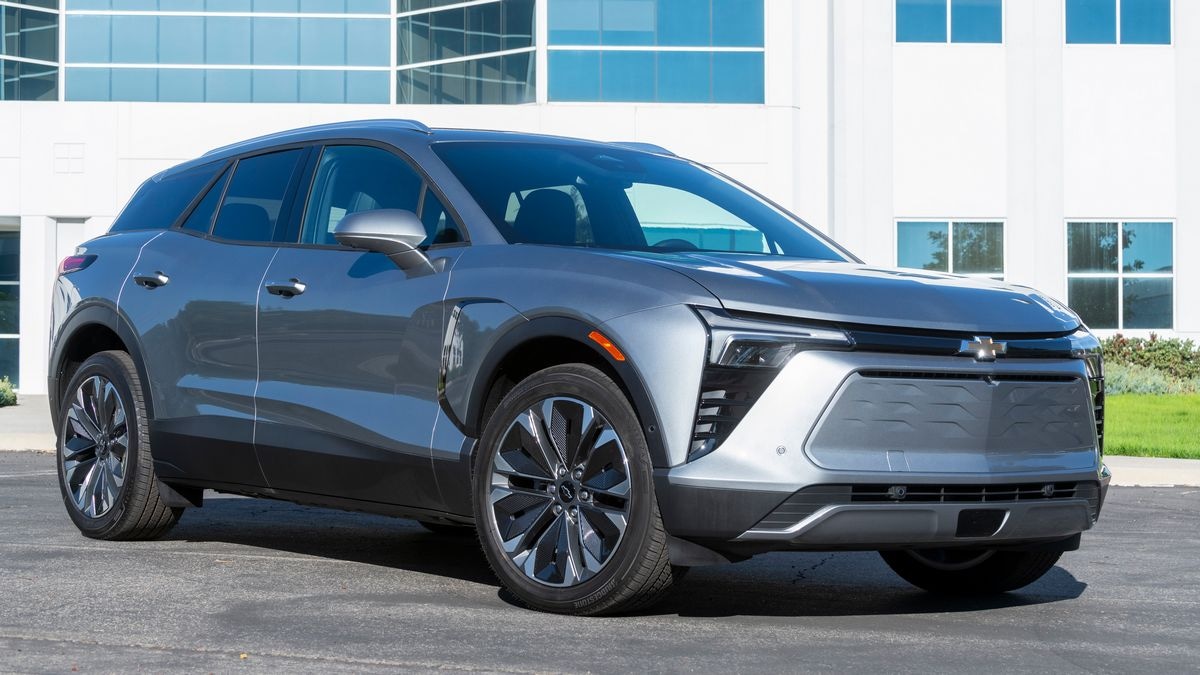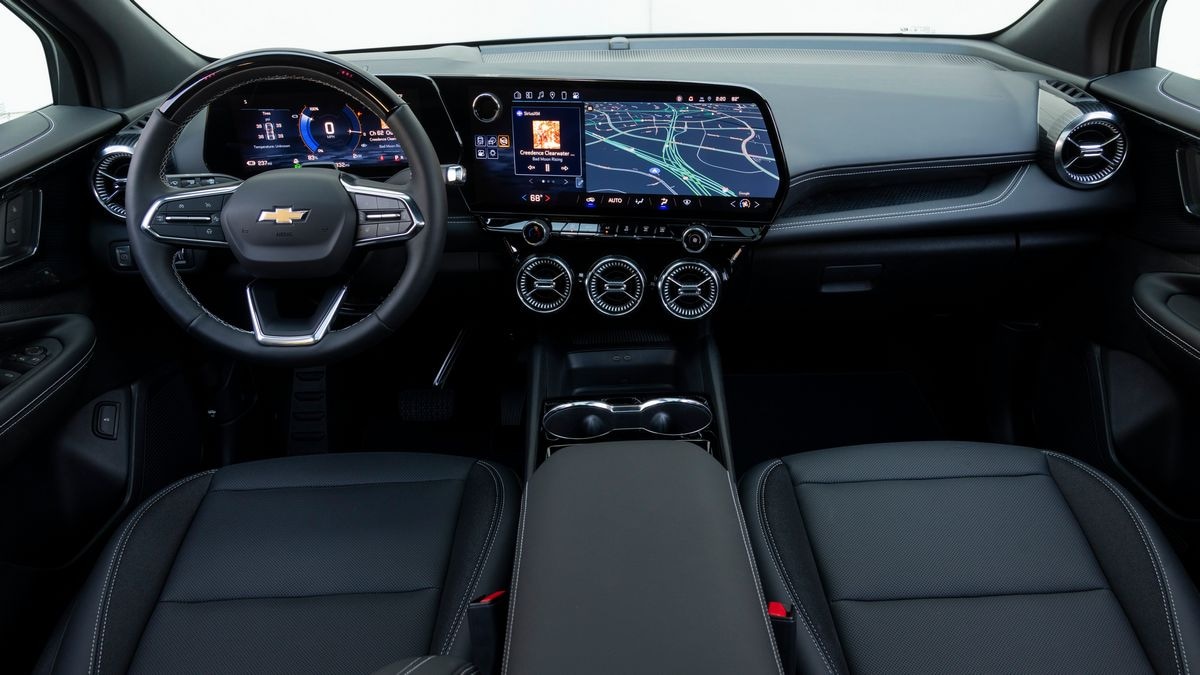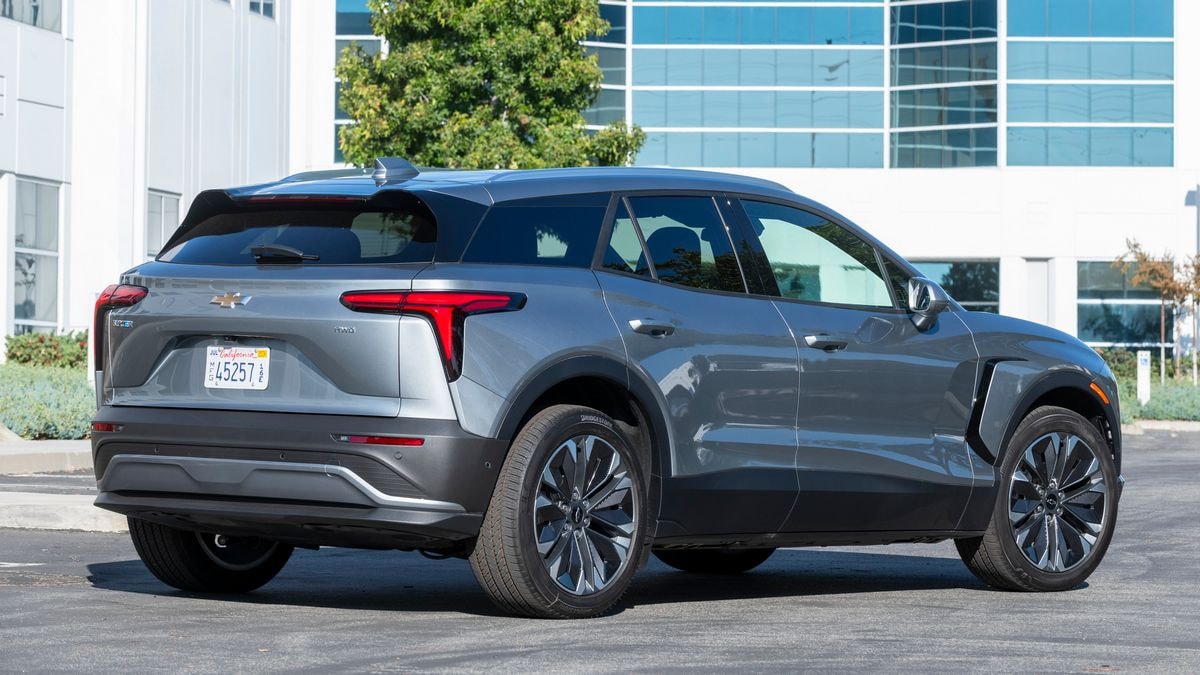2025 Chevrolet Blazer EV
2025 Chevrolet Blazer EV Review
By Russ Heaps
Updated February 28, 2025
Pros
- Loads of advanced tech
- Impressive max range
- Available Super Cruise
Cons
- Max range RS only
- Pricier than most rivals
- Lacks Android Auto/Apple CarPlay
What's New?
- SS is coming
- LT contrast roof color
- LT Midnight/Sport Edition
With its roomy interior, cutting-edge technology, and maximum-range number, the 2025 Chevrolet Blazer EV is a serious competitor in the electric midsize SUV segment. Pricing starts at $46,095.
The 2025 Chevrolet Blazer EV excels in silently transporting up to five adults and their gear comfortably, surrounded by plenty of advanced technology, both standard and optional. Chevy currently offers the 2025 Blazer EV in two trims: LT and RS. The LT comes standard with all-wheel drive (AWD), while you can get the RS with either all-wheel drive or rear-wheel drive (RWD).
Besides the healthy 334-mile maximum range, we like the Blazer EV for its generous cargo space, quiet operation, zippy acceleration, and an array of advanced safety and driver-assist technology.

We’ve spent hundreds of hours driving and evaluating this generation of electric SUVs, including the Chevy Blazer EV.
What's New for 2025
All new for 2024, the 2025 Blazer EV doesn’t have much in the way of updates. What there are pretty much pertain to the LT. It gets either an available white or black contrasting roof, power outboard mirrors, and new wheels. Also among the LT updates is the available Midnight/Sport Edition with black 19-inch wheels, gloss-black roof rails, and black Chevy bowtie badging. The RS grade does get in on the contrasting black roof. Finally, opting for Super Cruise qualifies you to also add Enhanced Automatic Parking Assist, which allows the Blazer EV to park itself. The range-topping SS grade with its jaw-dropping maximum 615 horsepower joins the trim lineup for 2025. It’s the first EV Chevy has adorned with the iconic SS (Super Sport) badge.
2025 Chevrolet Blazer EV Pricing
The 2025 Chevrolet Blazer EV has a starting sticker price of $46,095, with the range-topping Blazer EV SS kicking off at $62,095. But Kelley Blue Book Fair Purchase Pricing currently suggests paying $3,055 to $3,430 less than MSRP, depending on trim and equipment. These prices are updated weekly.
MSRP | KBB Fair Purchase Price (national avg.) | |||
|---|---|---|---|---|
$46,095 | $42,665 | |||
$51,395 | $48,140 | |||
$62,095 | $59,040 |
It must be said that the Blazer EV is not exactly cheap. The Ford Mustang Mach-E, Hyundai Ioniq 5, Kia EV6, Nissan Ariya, Volkswagen ID.4, and Tesla Model Y all start in the low-to-mid $40,000s range. Before buying a new Blazer EV SUV, check the Kelley Blue Book Fair Purchase Price to know what you should be paying.
If you want to spend less and stay in the Chevrolet family, we suggest the Chevy Equinox EV, which starts at about $9,000 less.
By the way, the Blazer EV may be eligible for a federal tax credit of up to $7,500 — see if you qualify.
Power, Ride, And Handling
The Chevy Blazer EV drives as well as or better than anything in the segment. We’re not totally surprised because we’ve been equally impressed by the Cadillac Lyriq, with which the Blazer EV shares much of its architecture. The Blazer EV simply goes, stops, and turns with remarkable refinement, delivering an exceptionally satisfying driving experience. We’ve found it smooth and easy around town — especially when using the excellent one-pedal driving mode — comfortable on the highway and more fun than most buyers will ever need it to be. The most common versions — 288 horsepower and all-wheel drive — will do zero-to-60 mph in about six seconds. This acceleration is in the same ballpark as a similarly outfitted Ford Mustang Mach-E and more than quick enough for the real world.
Hi-Tech Interior
Every Blazer EV is well equipped. The dashboard in the Blazer EV has up-to-the-minute styling and tech, with every model featuring an 11-inch digital instrument cluster and a honking-big 17.7-inch infotainment touchscreen. Passenger and cargo spaces are great, with the latter enhanced by fold-flat rear seats. We’ve also found that cabin materials are of decent quality. Our only gripe is that the choice of color schemes centers around various combinations of black and red. We’d prefer to see some lighter hues offered, which would work well in sunnier climates.

Fetching Outer Wrapper
There’s enough visual difference between the new Blazer EV and the gasoline-powered Blazer for onlookers to realize they’re separate entities. The Blazer EV is longer, lower, and generally sleeker. To our eyes, it comes across as the more futuristic of the two.
Our Favorite Features And Tech
Infotainment display
At 17.7 inches on the diagonal, this standard touchscreen is bigger than the one in the Mustang Mach-E. It’s also oriented horizontally, which makes a lot of sense when it’s part of a horizontal dashboard. We’ve found that the graphics are wonderfully sharp, the processing is speedy, and the Google-based system itself is user-friendly. Digging through menus is kept to a minimum. It’s a shame there’s no Apple CarPlay or Android Auto phone integration, though.
One-pedal driving
The highest level of brake energy regeneration in the Blazer EV enables drivers to speed up and slow down just by varying the pressure on the accelerator pedal. It’s only necessary to hit the brake pedal when a more urgent stop is required.
Remote access
Using the myChevrolet Mobile app, owners can lock/unlock doors and set the ideal cabin temperature (including heated seats). When done while it’s still charging, the Blazer EV will use energy from the charger, not the battery.
Comfort and Convenience Package
Not the most creative name for an option group, the Comfort and Convenience Package is an everything-but-the-kitchen-sink catch-all bundle for the LT. It includes an array of popular features, such as multi-adjustable power front seats, wireless phone charging, a heated steering wheel, an automatic power rear liftgate, and much, much more.
Super Cruise
General Motors’ superb hands-free driving technology works on more than 400,000 miles of roads in the United States and Canada. Super Cruise is an option in the two current trims of new Blazer EV models.
Efficiency, Range, And Charging
The estimated maximum range with a full battery is an enticing 334 miles. However, the catch is that maximum range is only possible with the rear-wheel-drive RS grade.
The Blazer EV LT and RS models with all-wheel drive are rated for 283 miles of range on a full charge. The rear-wheel-drive version of the Blazer EV RS has a bigger battery, delivering the estimated maximum range of 334 miles. For comparison, the Ford Mustang Mach-E California Route 1 has a maximum range of 312 miles. The Hyundai Ioniq 5 (long-range/rear-wheel drive) can manage 303 miles. The Nissan Ariya in Venture+ trim is rated at 304 miles. The class leader, though, is still the long-range version of the Tesla Model Y, at 330 miles.
All-wheel-drive examples of the Blazer EV employ an 85-kilowatt-hour (kWh) battery. That’s a pretty substantial capacity. The Mustang Mach-E has a 91-kWh unit, while the biggest battery in the Ioniq 5 is 77.4 kWh. The rear-wheel-drive RS variant has a 102-kWh battery.
The Blazer EV SS with its 102 kWh battery and all-wheel drive setup delivers up to 303 miles of range. Under optimum conditions 10 minutes on a DC fast charger adds up to 79 miles of range.
Connected to a public DC fast charger, the all-wheel-drive RS can take up to 68 miles of range in 10 minutes. That’s not especially quick. For example, the Ioniq 5 needs only five minutes for 68 miles of range or goes from 10% battery capacity to 80% in 18 minutes, which is about as good as it gets at the moment.
3-Year/36,000-Mile Warranty
Chevrolet’s new-vehicle limited bumper-to-bumper warranty lasts three years or 36,000 miles, whichever happens first. This coverage is typical among mainstream manufacturers, although Hyundai and Kia offer much better terms. The battery is covered for eight years or 100,000 miles. Also, Chevrolet includes five years or 60,000 miles of powertrain coverage, plus a free first service within one year or 12,000 miles.
Safety
The National Highway Traffic Safety Administration (NHTSA) issued its top 5-Star overall rating to the 2025 Blazer but hasn’t specifically tested the Blazer EV. Meanwhile, although the Blazer did well in its old battery of tests, the Insurance Institute for Highway Safety (IIHS) hasn’t performed any of its new crash tests on the Blazer EV. Standard safety features in the new Blazer EV include active blind-spot monitoring and forward collision warning with automatic emergency braking and pedestrian detection.

Cars You May Like
We’ve Rounded Up Cars That Could Be Your Perfect Match.
2025 Chevrolet Blazer EV Deals and Incentives
$3500 Total Cash
Get $3500*Customer Cash Plus $1250**Purchase Allowance for Current Eligible Non-GM Owners and Lessees on a new 2025 CHEVROLET Blazer EV.
2025 Chevrolet Blazer EV
KBB.com Consumer Reviews
Trending Topics in KBB.com Consumer Reviews
2025 Chevrolet Blazer EV Styles
2025 Chevrolet Blazer EV Cost to Own

The 2025 Chevrolet Blazer EV is in the top 11-25% for Cost to Own among all Mid-size SUV/Crossovers.
Calculate Your Budget With These KBB.com Tools
Specifications
Dimensions, Weights & Capacities
Curb Weight | 5009 lbs. | ||
|---|---|---|---|
Front Head Room | 40.9 inches | ||
Front Leg Room | 44.2 inches | ||
Max Seating Capacity | 5 | ||
Minimum Ground Clearance | 7.9 inches | ||
Overall Length | 192.2 inches | ||
Front Shoulder Room | 58.7 inches | ||
Towing Capacity, Maximum | 1500 lbs. | ||
Trunk or Cargo Capacity | 59.1 cu.ft. | ||
Turning Diameter | 39.7 feet | ||
Wheel Base | 121.8 inches | ||
Gross Vehicle Weight Rating (GVWR) | 6283 lbs. | ||
Width with mirrors | 86.5 inches |
Exterior
Alloy Wheels | Available | ||
|---|---|---|---|
Moon Roof/Sun Roof | Available | ||
Number of Doors | 4 doors | ||
Panorama Moon Roof | Available | ||
Power Folding Exterior Mirrors | Available | ||
Privacy Glass | Available | ||
Roof Rails | Available | ||
LED Headlights | Available |
Fuel Economy
City | 114 MPGe | ||
|---|---|---|---|
Combined | 104 MPGe | ||
Highway | 95 MPGe |
Mechanical
Drivetrain | FWD | ||
|---|---|---|---|
1 speed | Available | ||
Parking Assist System | Available |
Performance
Engine | Electric Motor | ||
|---|---|---|---|
Estimated Electric Range | 312 miles | ||
Charge Time (240V) | 9.5 hours | ||
Battery Capacity | 85.00 kwh |
Warranty
Basic | 3 years / 36000 miles | ||
|---|---|---|---|
Powertrain | 5 years / 60000 miles | ||
Corrosion | 3 years / 36000 miles |
Comfort & Convenience
Entertainment
Interior
Seating
Security
Technology
2025 Chevrolet Blazer EV Safety
Safety Features & Technology
Compare to Similar Vehicles
 New 2025 Chevrolet Blazer EV |  New 2025 Hyundai IONIQ 5 |  New 2025 Tesla Model Y |  New 2025 Chevrolet Equinox EV | ||
|---|---|---|---|---|---|
| Price | $46,095 | $44,100 | $49,880 | $34,995 | |
| KBB.com Rating | 4.6 | 4.7 | N/A | N/A | |
| Consumer Rating | 3.4 | 4.3 | 4.1 | 5.0 | |
| Fuel Economy | City 114/Hwy 95/Comb 104 MPGe | City 131/Hwy 100/Comb 115 MPGe | City 123/Hwy 111/Comb 117 MPGe | City 117/Hwy 99/Comb 108 MPGe | |
| Fuel Type | Electric | Electric | N/A | N/A | |
5 Year Cost To Own 5-Year Cost to Own includes out of pocket expenses like fuel and insurance, plus the car’s loss in value over time (depreciation). | $57,641 | $61,335 | N/A | $49,487 | |
| Estimated EV Range | 312 miles | 245 miles | 311 miles | 319 miles | |
| Safety Rating | N/A | N/A | N/A | 5.0 | |
| Seating Capacity | 5 | 5 | 7 | 5 | |
| Basic Warranty | 3 years or 36000 miles | 5 years or 60000 miles | 4 years or 50000 miles | 3 years or 36000 miles | |
| 0-60 | N/A | N/A | 4.8 seconds | N/A | |
| Horsepower | N/A | 168 HP | N/A | N/A | |
| Engine | Electric Motor | Electric Motor | Dual AC Electric Motors | Electric Motor | |
| Drivetrain | FWD | RWD | AWD | FWD |
Best EVs
More Chevrolet Blazer EV News & Information
We found the high-performance 2025 Chevrolet Blazer EV SS capable on the track, in traffic, and on a gravel road.
You can once again buy a 2024 Chevy Blazer EV. General Motors has resumed selling the model after a months-long…
The Chevrolet Blazer electric vehicle (EV) has just begun appearing on sales lots. But if there’s one at your local…
FAQs
How far can the 2025 Chevy Blazer EV go on a full charge?
The maximum estimated range for the Chevy Blazer EV is for the rear-wheel-drive RS trim at 334 miles.
How long does it take to charge the 2025 Chevrolet Blazer?
Using a DC fast charger, the Chevrolet Blazer can add between 68 (all-wheel drive) and 87 (rear-wheel drive) miles of range to the battery in 10 minutes or so. Front-wheel drive models can add about 81 miles while SS version can add about 79 miles of range in the same time frame.
How big is the touchscreen in the 2025 Chevy Blazer EV?
The infotainment touchscreen in the Chevy Blazer EV, measuring 17.7 inches, complements an 11-inch customizable driver digital information display. That’s a total of nearly 30 inches of color display.
Is the 2025 Chevrolet Blazer EV a good buy?
The 2025 Chevrolet Blazer EV is a good buy for most Electric Vehicle shoppers. It gets strong ratings from our experts and most buyers are paying less than sticker price.
How much should a 2025 Chevrolet Blazer EV cost?
A 2025 Chevrolet Blazer EV should cost between $42,665 and $59,040 according to Kelley Blue Book Fair Purchase Pricing.
What's the cheapest Chevrolet Blazer EV?
The cheapest 2025 Chevrolet Blazer EV is the LT, with a starting sticker price of $46,095 and a Kelley Blue Book Fair Purchase Price of $42,665.
Is the 2025 Chevrolet Blazer EV reliable?
The 2025 Chevrolet Blazer EV is part of the 1st-generation Blazer EV, which our owners give an above-average reliability rating of 4.5 out of 5.







